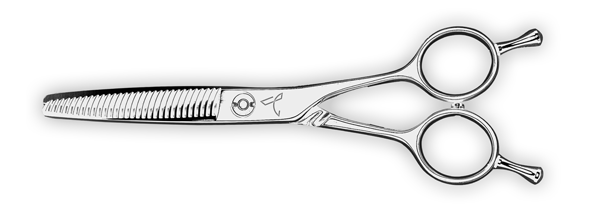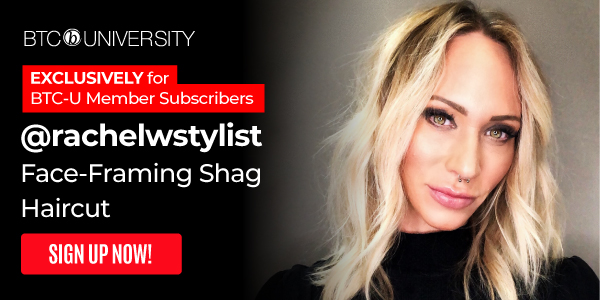SHAG 101: The Dos And Don’ts
Learn The Major Dos & Don’ts Of Cutting Shags
The shag haircut can be an intimidating cut when you are first attempting it. From section elevation to texturizing techniques, it can seem confusing but the shag is a highly customizable and versatile cut if you know how to slay it. We reached out to ARC™ Scissors Architect and shag expert Rachel Williams (@rachelwstylist) to get all of her tips and tricks to ease your anxiety and set you up for success!
What is a shag haircut?
Originally created by barber Paul McGregor, the shag traditionally consists of layers that are feathered at the top and sides, making the hair full around the crown and thinner around the edges and throughout the ends.
“The shag is ideal for medium to thick hair types and straight, wavy or curly hair. It’s a cut for all lifestyles, but if you’re a tousle and go type, this cut is perfect for you. It’s low-maintenance and really shows off the natural texture of the hair. It’s perfect to style with a little volume mousse, let air dry or diffuse with a blow dryer. Because of its face-framing layers, it really accentuates the woman’s face,” explains Rachel.
What are the key things to consider when cutting a shag?
1. Consultation
Since the shag has so many layers, it removes a lot of weight out of the hair and can catch a client off guard. “I feel that it is super important to always have a consultation first so the client fully understands the haircut and is not alarmed when they see so much hair being removed,” shares Rachel. “It can be shocking to women who are used to one length and long hair.”
2. Texture
Rachel approaches a shag cut differently depending on the client’s texture. It is important to take into consideration the client’s natural texture as well as how the client wears their hair 90 percent or more of the time. When cutting hair that is naturally straight, Rachel performs the entire cut wet and then details when it is dry. For hair that is wavy or curly, she prefers to cut the hair dry in its natural state in order to really customize and cater to the texture so it is easy to maintain and style.
3. Density
The shag haircut works on all density levels. However, a lot of people tend to mix up fine hair and thin hair. “I will never recommend a shag for thin hair because it is such a layered cut that it will take out too much weight and look like a mullet,” notes Rachel.
4. Length
Rachel likes to establish her client’s desired length first because it will be her guide to the rest of the cut. “Start with the hair below the occipital bone and hold the section straight out to 90 degrees. Cut your desired length and establish your perimeter. This will be your guide for the rest of your cut,” explains Rachel.
What are some of the biggest mistakes you can make when cutting a shag?
1. Removing too much weight.
“One of the biggest mistakes made when cutting a shag is taking too much weight out of the mid and bottom layers, which can create an outdated mullet. An easy way to prevent this from happening is to leave the section behind the ear out. The hair has less density in that area so it is best to detail that section when the hair is dry and in its natural state. “This section can make or break the way your shag looks and take it from Marsha Brady to modern. We take hair cuts and evolve them by detailing dry and catering to each clients hair type,” explains Rachel.
2. Not using your guide.
After you have established your length, use that as your guide for the rest of the cut. Rachel loves to create her framework of the cut on wet hair using her 6″ ARC™ Scissors PHANTOM II. Why does this matter? “That’s when you see midsections looking too thin and the top becoming too heavy. Without a guide, you will create uneven weight and ultimately, an unbalanced haircut with and a lot of weight lines,” says Rachel.
Ready To Put Rachel’s Tips To The Test? Click Here To Purchase The PHANTOM II From ARC™ Scissors!
3. Detailing on wet hair.
“Always detail a shag haircut when the hair is dry because the way the hair lays changes from wet to dry,” recommends Rachel. Don’t remove weight on wet hair because it can be easy to take too much weight out. “It’s always important to detail hair when it’s in its natural state to truly take only the necessary weight out,” says Rachel. “I like to use my ARC™ Scissors™ SYMMETRY 30/2 Reversible Blender on the hair when it is dry to remove weight and texturize the bangs and face-framing layers.”
Ready To Try Rachel’s Texturizing Tricks? Click Here To Purchase The SYMMETRY 30/2 Reversible Blender From ARC™ Scissors!
4. Bulky fringe.
One of the biggest mistakes when cutting fringe is taking your section too far back. Rachel recommends always following the curvature of the head and using a comb to determine where the head starts to round. Watch the video below to see how Rachel starts her cut!
View this post on Instagram
Rachel recommends always starting with the fringe and face frame first, no matter what the length is, so the top has a reference point to connect with the bangs. When it comes to establishing the length of your fringe, ask your client what she is most comfortable with in terms of where on her face she wants the bangs to lay. Rachel recommends taking bangs a little shorter if the overall length of the cut is shoulder length or shorter to give more of an overall shag look.
To watch Rachel’s entire shag haircut, click here!
Want More ARC™ Scissors Education? Click Here To Visit Our Education Page!
More from
ARC™ Scissors
-
Blowouts
Bob Styling Guide: 5 Ways To Style Short Hair
-
BTC Hair Trend Report
The Biggest Haircut Trends of 2024
-
Dry-Cutting
Bang Breakdown: How To Cut 2024’s Top Fringe Trends
-
Dry-Cutting
2024 Fringe Guide: How To Consult, Cut & Style Trendy Bangs
-
BTC University
10 Gifts & Stocking Stuffers on Every Hairdresser’s List This Year
-
BTC Events
BTC “On Tour” Nashville Recap: Everything You Missed
-
BTC Hair Trend Report
The Biggest Haircut Trends of Fall & Winter 2023
-
BTC Hair Trend Report
Layering Guide: How To Cut & Style With Confidence
-
Bobs
The ’90s Bob: How To Cut & Style This Trending Haircut
-
Facebook Lives
Volume Guaranteed: Try This Layering Technique For Fine Hair
-
Barbering
How To Style The Biggest Men’s Summer Trends
-
Bobs
The Biggest Haircut Trends of Summer 2023
-
Bobs
The French Bob: How to Cut it
-
Bobs
The Bixie: 3 Cutting Techniques to Master the Look
-
Brunette
Trend Breakdown: Hailey Bieber’s Glazed Brunette
-
Barbering
2023’s Top 9 Hair Trends For Men
-
BTC Hair Trend Report
2023 Fringe Guide: How To Cut This Year’s Biggest Trends
-
BTC Hair Trend Report
2023 Hairstyling: 11 Trends You Need To Know
-
BTC Hair Trend Report
Invisible Layers: What This Haircut Trend Really Means
-
BTC Hair Trend Report
2023’s Biggest Haircut Trends
-
Bobs
Hailey Bieber’s “Preppy, Contoured Bob” Trend: What You Should Know
-
BTC University
4 Styling Secrets For Butterfly Layers
-
This Year’s BIGGEST Products: 2022’s Most Talked About
-
Bobs
The Biggest Winter Haircut Trends To Kick Off 2023












